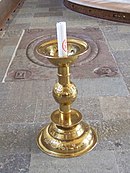candle holder

Candlesticks or candle holders are options for setting up candles . In the past they were used to illuminate rooms and up to the present day as religious symbols (for example the menorah , or dikirion and trikirion in the Orthodox churches ).
construction
Candlesticks usually consist of a heavier foot, which often merges into a slimmer shaft. A handle is sometimes attached to this shaft or the shaft has a knob-like thickening near the middle, called a nodus , which can also be set with precious stones. The candle can be received either by a round shape into which the candle is inserted, or by a tip onto which the candle is impaled. A holder made of spirally turned metal is also possible, which enables a vertical position of the candle even on non-horizontal surfaces. Usually a plate-shaped or cup-shaped drip guard is attached just below the candle holder. In modern art, compact candle holders without a shaft are also offered, where the base of the candle holder also has the function of drip protection.
Candlesticks are made from a variety of materials, most of which are themselves non-flammable. Castable (aluminum, tin and tin alloys, for example brass or bronze ) or forgeable metals such as iron, copper, silver, and sometimes gold with precious stones can be used. Furthermore ceramic ( earthenware , porcelain ) or mineral materials ( glass , crystal , agate , onyx ) can be used, sometimes just stone, for example marble .
A candlestick is sometimes mistakenly equated with a candlestick. A candlestick is an object that can be placed on a flat surface, i.e. a free-standing object. A candle holder, on the other hand, is mainly intended for attaching a candle to other objects (for example the Advent wreath ). It can be attached to uneven objects or vertical walls, for example with clips or skewers, but sometimes it can also be tied down with simple metal leaves or wires . If wood is used for carving or turning , the candle holder receives a non-flammable application . This is usually a small metal cup that tapers slightly conically down to a slightly smaller diameter than the candle to be held. This cup is also called a candle holder and is screwed or glued to the candle holder.
use

Candlesticks hold the candle in a vertical position and prevent it from tipping over. They enable the transport of a burning candle that has already burned far down and serve as drip protection. When using a glass cylinder, which protects the candlelight from unwanted blowing out by wind, the candlestick is then called a lantern . Since the introduction of gas lamps and electrical lighting , candlesticks and the candle standing on them have been used as decorative elements, although the candle is often only used for decorative purposes.
Cultural reception
Candlesticks are shown as a central element in paintings (mainly on still lifes ), for example in vanitas still lifes as a symbol of transience or as an accessory to other motifs. The candlestick can also play a central role in picture stories. In crime and horror films, a heavy candlestick is sometimes used as a striking weapon.
history
The earliest written evidence of a candlestick is on two Greek letters (P.Tebt. II 413-414) on papyrus from probably the 2nd to 3rd centuries AD , which was recovered in 1899 during excavations in Tebtynis . In ancient Rome , bronze candlesticks were cast in late antiquity . Because bronze was an expensive material at the time (the tin required for this alloy was not found on the Apennine Peninsula ) these candlesticks were a status symbol for the owner. In the Middle Ages, however, forged iron candlesticks were used. In the Ore Mountains , because of the rich tin deposits, candlesticks could also be cast from tin.
Web links
Individual evidence
- ^ Catholic Encyclopedia, Candle Stick
- ↑ a b Wrought iron candlesticks in Altena Castle museums around the 19th century ( online )
- ↑ Pewter altar candlesticks , object from: Altena Castle Museum
- ^ Brass candlesticks from the National Museum of Art , New York
- ↑ James Bainbridge; et al .: Turkey Ostfildern: MairDumont, 2010., ISBN 9783829716468 ( reading sample online )
- ↑ Ceramic candle holder from the National Museum of Art , New York
- ↑ Candlestick from Chalcedony , Germany, around 1700 to 1720, in the Kunstkammer of the Dukes of Württemberg.
- ↑ Dictionary Wortscheutung.info Candlesticks
- ↑ https://nat.museum-digital.de/index.php?t=objekt&oges=219066&cachesLoaded=true
- ↑ Wilhelm Busch: The birthday or the particularists , paragraph "Nocturnal Politics" ( online )
- ↑ The figure Lumière in Beauty and the Beast (1991)
- ↑ For example in Police Call 110: Kleine Frau , Das Duo: Echte Kerle , Ekel (1965) ...
- ↑ University of Heidelberg P. lives. II 413
- ↑ University of Heidelberg P. lives. II 414
- ↑ Review of N. Quenouille (Ed.): "From the time of the pharaohs to late antiquity"
- ↑ Pewter candle holder , depicts a miner with an ore trough on his shoulders. (GoetheStadtMuseum Ilmenau)